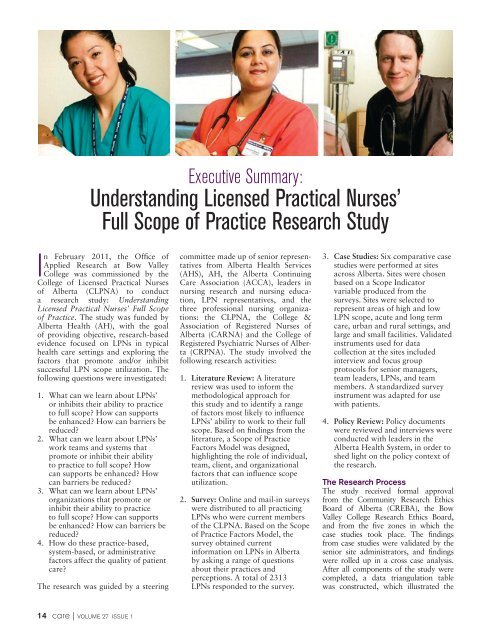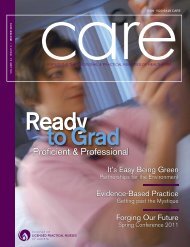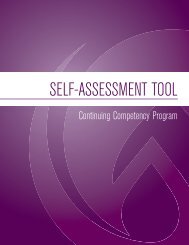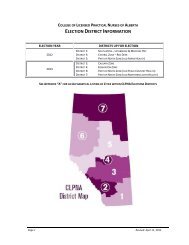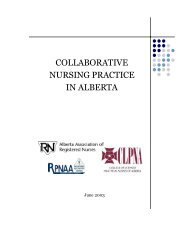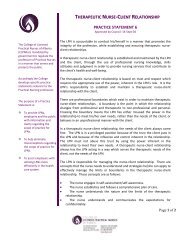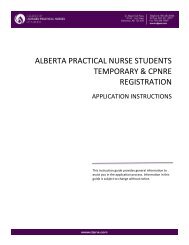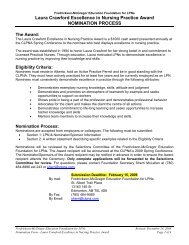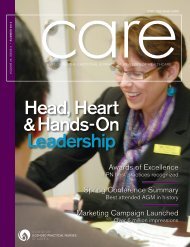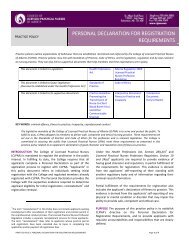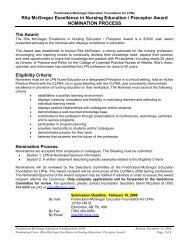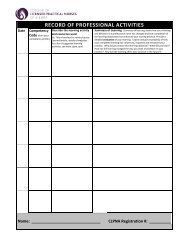Executive Summary:Understanding <strong>Licensed</strong> <strong>Practical</strong> <strong>Nurses</strong>’Full Scope <strong>of</strong> Practice Research StudyIn February 2011, the Office <strong>of</strong>Applied Research at Bow Valley<strong>College</strong> was commissioned by the<strong>College</strong> <strong>of</strong> <strong>Licensed</strong> <strong>Practical</strong> <strong>Nurses</strong><strong>of</strong> <strong>Alberta</strong> (CLPNA) to conducta research study: Understanding<strong>Licensed</strong> <strong>Practical</strong> <strong>Nurses</strong>’ Full Scope<strong>of</strong> Practice. The study was funded by<strong>Alberta</strong> Health (AH), with the goal<strong>of</strong> providing objective, research-basedevidence focused on LPNs in typicalhealth care settings and exploring thefactors that promote and/or inhibitsuccessful LPN scope utilization. Thefollowing questions were investigated:1. What can we learn about LPNs’or inhibits their ability to practiceto full scope? How can supportsbe enhanced? How can barriers bereduced?2. What can we learn about LPNs’work teams and systems thatpromote or inhibit their abilityto practice to full scope? Howcan supports be enhanced? Howcan barriers be reduced?3. What can we learn about LPNs’organizations that promote orinhibit their ability to practiceto full scope? How can supportsbe enhanced? How can barriers bereduced?4. How do these practice-based,system-based, or administrativefactors affect the quality <strong>of</strong> patientcare?The research was guided by a steeringcommittee made up <strong>of</strong> senior representativesfrom <strong>Alberta</strong> Health Services(AHS), AH, the <strong>Alberta</strong> ContinuingCare Association (ACCA), leaders innursing research and nursing education,LPN representatives, and thethree pr<strong>of</strong>essional nursing organizations:the CLPNA, the <strong>College</strong> &Association <strong>of</strong> Registered <strong>Nurses</strong> <strong>of</strong><strong>Alberta</strong> (CARNA) and the <strong>College</strong> <strong>of</strong>Registered Psychiatric <strong>Nurses</strong> <strong>of</strong> <strong>Alberta</strong>(CRPNA). The study involved thefollowing research activities:1. Literature Review: A literaturereview was used to inform themethodological approach forthis study and to identify a range<strong>of</strong> factors most likely to influenceLPNs’ ability to work to their fullscope. Based on findings from theliterature, a Scope <strong>of</strong> PracticeFactors Model was designed,highlighting the role <strong>of</strong> individual,team, client, and organizationalfactors that can influence scopeutilization.2. Survey: Online and mail-in surveyswere distributed to all practicingLPNs who were current members<strong>of</strong> the CLPNA. Based on the Scope<strong>of</strong> Practice Factors Model, thesurvey obtained currentinformation on LPNs in <strong>Alberta</strong>by asking a range <strong>of</strong> questionsabout their practices andperceptions. A total <strong>of</strong> 2313LPNs responded to the survey.3. Case Studies: Six comparative casestudies were performed at sitesacross <strong>Alberta</strong>. Sites were chosenbased on a Scope Indicatorvariable produced from thesurveys. Sites were selected torepresent areas <strong>of</strong> high and lowLPN scope, acute and long termcare, urban and rural settings, andlarge and small facilities. Validatedinstruments used for datacollection at the sites includedinterview and focus groupprotocols for senior managers,team leaders, LPNs, and teammembers. A standardized surveyinstrument was adapted for usewith patients.4. Policy Review: Policy documentswere reviewed and interviews wereconducted with leaders in the<strong>Alberta</strong> Health System, in order toshed light on the policy context <strong>of</strong>the research.The Research ProcessThe study received formal approvalfrom the Community Research EthicsBoard <strong>of</strong> <strong>Alberta</strong> (CREBA), the BowValley <strong>College</strong> Research Ethics Board,and from the five zones in which thecase studies took place. The findingsfrom case studies were validated by thesenior site administrators, and findingswere rolled up in a cross case analysis.After all components <strong>of</strong> the study werecompleted, a data triangulation tablewas constructed, which illustrated the14 care | volume 27 issue 1
consistency <strong>of</strong> findings from the fourdata sources and provided opportunity tosee where findings were congruent withprevious research, while also highlightingnew and contradictory results.Study FindingsStudy results were categorizedaccording to the individual, team,organizational, and system factorsfound to affect LPN scope utilization.Key findings are presented below:Individual factors• There has been an increase in bothperceived and actual LPN scopeutilization compared with earlierstudies, yet a gap between LPNs’perceptions <strong>of</strong> skill utilization and theiractual practice exists.• LPNs varied in terms <strong>of</strong> theircertification (certificate or diploma)and the amount and content <strong>of</strong> postbasiceducation they had attained.More formal education was associatedwith improved nursing competencies,confidence, critical thinking, and mathskills. In long term care facilities,more education was also linked to animproved ability to communicate withresidents and families.• Overall job satisfaction among LPNswas found to be quite high. LPNswho reported using more <strong>of</strong> theircompetencies had a significantly higherlevel <strong>of</strong> job satisfaction. A higherproportion <strong>of</strong> LPNs at low scope casestudy sites reported dissatisfactionwith their job compared with LPNs athigh scope sites.• LPNs were generally motivated totake advantage <strong>of</strong> opportunities forpr<strong>of</strong>essional development, includingtaking on additional competenciesand responsibilities in the workplace.Conversely, a lack <strong>of</strong> motivation onthe part <strong>of</strong> some LPNs to expand theirskill set was seen by coworkers to posea barrier to full scope utilization.Team factors• A lack <strong>of</strong> time and a heavy workloadinterfered with the range <strong>of</strong> skills LPNscould perform. LPNs tended to takeon more responsibilities, in instanceswhere fewer RNs were available onthe unit, such as during night shiftsor when LPNs were called in by unitmanagement as a financial strategy toavoid going into overtime with an RN.• Variability in assignment was usuallylinked to individual team leaders.In acute care settings in particular,assignment was based largely on thepatient’s level <strong>of</strong> complexity• By and large, LPNs were seen bycoworkers as valued members <strong>of</strong> theircare teams. Though there was somevariation in the degree to which greaterLPN scope utilization was embracedby RNs, a number <strong>of</strong> them describedhigher LPN scope utilization as aneffective workforce strategy.• Management and leaders <strong>of</strong>tenprovided opportunities for LPNs topractice new and infrequently usedskills. Variation in understanding andacceptance <strong>of</strong> LPN scope was evidentamong team members and managers.• Collaboration and communicationwere related to the optimization <strong>of</strong> careteam roles, and poor communicationwas a significant barrier. LPNs at highscope sites received guidance, teaching,and mentoring from RNs and otherteam leaders. The value <strong>of</strong> peer supportwas also noted.Organizational factors• Role ambiguity remains a keybarrier to LPN scope utilization.Inconsistencies in the accuracy <strong>of</strong> LPNjob descriptions in relation to their dayto-daywork were frequently noted.• Managerial encouragement for LPNsto enrol in post basic training wasnot always matched by funding and/or formal approval to participate.Post-basic training, pr<strong>of</strong>essionaldevelopment opportunities, andorganizational support for these variedby site.System factors• There is a lack <strong>of</strong> clarity with regardto regulations and policy throughoutthe system, and more direction fromgovernment and/or governing bodieswas sought.• Senior leaders indicated a strongcommitment to policy change withregard to the expanded capabilities<strong>of</strong> the LPN role, and describe it as “awork in progress”.RecommendationsAs a result <strong>of</strong> discussion with the studysteering committee, five broad-basedrecommendations were proposed.These are expected to enable a number<strong>of</strong> strategies related to the utilization<strong>of</strong> LPNs to their full scope <strong>of</strong> practice,which are outlined in the full report. Itis recommended that:1. A strong case to be made to<strong>Alberta</strong> Health to lead the creationand articulation <strong>of</strong> a clear,compelling and shared vision <strong>of</strong>differentiated nursing practice in<strong>Alberta</strong>.2. Regulatory bodies, employers,and individual LPNs assume jointresponsibility and accountability toidentify, provide, and accesslearning opportunities.3. A detailed strategic plan andimplementation plan be developedto assist all players with theirrole in implementing andfacilitating change.4. Research be conducted to studythe roles and opportunities forLPNs in emergency care, familycare clinics and primary care,labour and delivery, mental health,home care, and leadership.5. A knowledge translation plan becreated with input from allstakeholders to ensure that thefindings <strong>of</strong> the study and itsrecommendations are widelydisseminated and used.Authors:Rena Shimoni, PhDProject Director and Co-Principal InvestigatorGail Barrington, PhDCo-Principal InvestigatorContact:Russ WildeDirector, Learning Resource ServicesBow Valley <strong>College</strong>Email: rwilde@bowvalleycollege.caThe full research report can beaccessed at www.clpna.com.CLPNA extends sincere appreciation to theresearch team, steering committee, employers,and participants in this valuable research about<strong>Licensed</strong> <strong>Practical</strong> <strong>Nurses</strong> in <strong>Alberta</strong>.care | spring 2013 15


